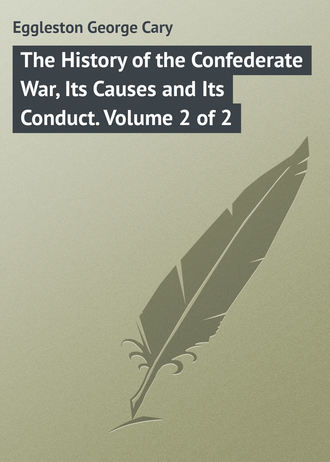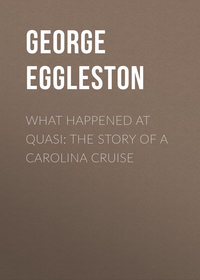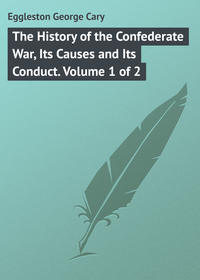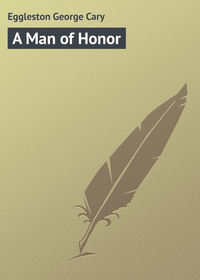 полная версия
полная версияThe History of the Confederate War, Its Causes and Its Conduct. Volume 2 of 2
These two – Longstreet and Hancock – were both old fighters and very stubborn ones, and they had under their command the very best men there were in their respective armies. When they met in direct conflict at close quarters, therefore, the fighting was as obstinate as any that had yet occurred on any field since the beginning of the war.
Hancock was driven back and the losses on both sides were great, including a conspicuously large loss of officers from the lowest to the highest grade. General Wadsworth on the Federal side, and General Jenkins on the Confederate, were killed, and Longstreet himself was shot through the neck and shoulder so that he had to be carried from the field.
Having thus lost his great lieutenant, General Lee went to that quarter of the field and took personal command in Longstreet's place. It was then that one of the most picturesque incidents of the war occurred. Impressed with the desperate necessity of carrying a certain peculiarly difficult position, General Lee seized the colors of a Texas regiment and undertook to lead the perilous assault in person. The troops loudly protested against such an exposure of their beloved general to danger, and the Texas colonel, in behalf of his men and amid their applause, solemnly promised that they would carry the point at all costs and all hazards if Lee would go to the rear. Finally, Lee's bridle rein was seized, and he was forcibly taken to the rear, while the Texans advanced to the charge with the battle cry of "Lee to the rear!" upon their lips. The incident has been exquisitely celebrated in song by the poet John R. Thompson.
Under inspiration of this incident, the Confederates made an assault of desperate determination, and at one point broke through the Federal lines. They captured the position for the recovery of which Lee had sought to sacrifice himself, but the result was achieved at tremendous cost of life, and their further efforts to dislodge Hancock were bloodily repelled.
By some means – probably by reason of the fierce firing on either side – a forest fire now broke out in Hancock's front, and the flames quickly communicated themselves to the log revetments of his fortifications. The heat and the smoke forced the Federals to retreat, fighting as they went against the Confederates who pursued them with fury. Sadly enough, besides the dead there were large numbers of wounded men, both Federal and Confederate, lying among the burning bushes and underbrush of that mile-wide stretch of wilderness over which the flames swept. Here misfortune and sheer accident wantonly added to the necessary horrors of war another horror not contemplated or intended by either commander although that, like all other risks of battle, is included in the contract which the soldier makes with his country. These men, wounded and helpless as they lay amid the flames that circled and enwrapped them, must have realized as nobody unaccustomed to the horrors of war can, the truth of Sherman's statement that "war is all hell."
Night ended the struggle, and the men on both sides retired to their entrenchments to await the events of the morrow. On neither side was there the least suggestion of demoralization or of shrinking from the work that was yet to be done. On neither side were there skulkers in the rear as there had been at Manassas, at Shiloh and at nearly every other great battle of an earlier time. The volunteers who composed the armies of the Potomac and Northern Virginia were real soldiers now, inured to war, and desperate in their determination to do its work with out faltering or failure. This fact – this change in the temper and morale of the men on either side – had greatly simplified the tasks set for Grant and Lee to solve. They knew their men. They knew that those men would stand against anything, endure slaughter without flinching, hardship without complaining, and make desperate endeavor without shrinking. The two armies had become what they had not been earlier in the contest, perfect instruments of war, that could be relied upon as confidently as the machinist relies upon his engine scheduled to make so many revolutions per minute at a given rate of horse power, and with the precision of science itself.
It will be remembered that as Jefferson Davis approached the battlefield of Manassas, where the Confederates had won a conspicuous victory, the multitude of panic-stricken fugitives through whom he passed was such as to convince him that Beauregard had been disastrously defeated. It will be remembered that at Shiloh when Grant made his way to the front he was appalled by the presence under shelter of the river banks of a multitude of fugitives, demoralized and panic-stricken, who ought to have been at the front lying on their bellies and firing at the enemy. Nothing of the kind occurred on either side at the Wilderness. The war school had perfectly educated its pupils.
The losses in these two days of fighting in the Wilderness have never been accurately ascertained, and never will be. The best estimates fix them at about 15,000 or 16,000 men on either side. These losses included, as has already been said, a remarkable number of officers of high grade on both sides. Nothing could be more significant than this of the determination with which the battle was fought.
In the strictest sense of the military term this had been a drawn battle. Neither side had overcome the other and neither had driven the other into retreat. Yet each side has claimed it as a victory upon grounds which are logical enough in themselves. The Confederates held that by checking Grant and baffling his plan of marching out of the Wilderness, and forcing Lee to a fight in the open, they had accomplished a very distinct victory. The Federals held, that, as they had succeeded in placing their army securely south of the Rapidan and in a position to carry on a further campaign, and that as they had not been so far damaged in the fight as to feel themselves under compulsion of retreat, they were entitled to regard the general result of the two days' fight as a victory for themselves.
There is no doubt whatever that at the end of this struggle the Confederates expected Grant to retire to the northern side of the river, as all his predecessors had done after similar conflicts. When the next morning dawned and Grant still stood firm in their front they were astonished to find him there. Among the men no explanation of his continued presence in the wilderness was forthcoming. In the mind of Lee there was an explanation ready and sufficient. The great Confederate general is reported to have said to his staff on that morning, "Gentleman, at last the Army of the Potomac has a head."
CHAPTER XLVI
Spottsylvania and the Bloody Angle
All day during the seventh of May the two armies lay still. There was a little cavalry fighting at Todd's Tavern, but the two great armies did not again engage each other in conflict. They had tried conclusions here, and each was measurably satisfied with the result.
The question now was where next they should meet each other in arms. Lee had chosen the field of the first onset. It was for Grant to choose the next. And in pursuance of his strategy Grant determined to move by his left flank to Spottsylvania Court House, hoping to reach that position before his adversary could get there, and to seize upon its best strategic points. In that position he would still have the great waterways at his back as a support, and a trustworthy source of supply. His desire was throughout the campaign to thrust his army in between the Army of Northern Virginia and Richmond, and this seemed to be his best opportunity to do so. He had somewhat a shorter line of march, and moreover by taking the initiative he was able to start first. If he was baffled in the attempt it was only by reason of the alertness of Lee's genius which penetrated his purpose, grasped his thought, and promptly acted in contravention of it.
Spottsylvania Court House lay fifteen or sixteen miles southeast of the Wilderness battlefield, and nearly that far southwest of Fredericksburg. In order that the movement might be made without danger of his army being attacked while in motion, Grant adopted the plan of using the troops on his right as the advance force of his movement towards the left. He did this throughout that campaign by the left flank, always withdrawing the forces on his right, passing them in rear of his main army, and thus making of the movement what is technically known as a countermarch. In this way the advancing troops had always the main army between them and the enemy until they cleared the position occupied, and were well on march toward the new one aimed at. After that, of course, they must take care of themselves, but in the meanwhile the march was begun without discovery on the part of the enemy.
The movement on this occasion was begun at nine o'clock in the evening, on the night of Saturday, May 7. With his extraordinary alertness and penetration Lee anticipated it and obstructed it. He threw a force of cavalry across the roads that Grant's head of column must traverse, and directed it to oppose and delay the movement so far as it was possible to do so. He also sent sappers and miners ahead to fell trees across the road over which Grant must march, then with caution, but with boldness, he set his own columns in motion, sending the head of them to seize upon and hold the strongly strategic positions at Spottsylvania until such time as Grant's movement should so far develop itself as to justify him in moving his whole army into that position. The Federal cavalry had occupied these strategic positions before the Confederates got there, but they were quickly brushed away, and by the time that the head of Grant's column of infantry and artillery reached Spottsylvania, Lee's advance was in full possession and everywhere throwing up earthworks. The remainder of Lee's forces were quickly brought up, as were those of Grant, and the two great armies again confronted each other, each with set lips, determined to get the better of the other if human resolution could accomplish that purpose.
In the meanwhile Grant had sent Sheridan with a strong force of cavalry to ride around the Confederates as Stewart had thrice done around the Federal army, to disturb their communications, and obstruct their avenues of retreat in case of disaster. His movement was promptly met by the Confederate cavalry under their great leader J. E. B. Stuart, and the two forces fell a-fighting at a point known as the Yellow Tavern, seven or eight miles north of the city of Richmond. There in fierce conflict Stuart met the death which he had always declared that he longed for. He was mortally wounded at the head of his men while making one of those tremendous onsets which it was the pride of his soul to conduct. With Stuart disabled, the Confederate cavalry was left without a leader capable of making the most of its dash and prowess, and Sheridan succeeded in breaking through the outer lines around Richmond, but not in going farther. He retreated and rejoined the army under Grant on the twenty-fifth of May, seventeen days after the time of his setting out.
The first casualty of importance at Spottsylvania was the killing of General Sedgwick by a Confederate sharpshooter. This one sharpshooter had already sent his bullets through twenty men as the Federals were trying to establish themselves in position. So deadly was his aim that in spite of the distance he seemed to be able to hit anybody that he shot at. After a little experience with him the men who were engaged in erecting fortifications shrank from their work, and General Sedgwick rebuked them, saying that at such a distance the best sharpshooter couldn't hit an elephant. A moment later he fell dead pierced through by a bullet from the sharpshooter's rifle.
By the evening of the ninth of May the two armies confronted each other, each behind its breastworks. A little fighting of a severe character occurred that evening on the Confederate left, both sides losing heavily, and neither gaining any advantage of moment. On the next day the fighting was renewed with desperation upon both sides. Several times the Federalists reached the Confederate breastworks, and held them for a few moments, but upon every occasion they were driven back. In their retreat they carried away some prisoners, some battle flags, and other trophies, but none of the guns that they had temporarily captured.
Thus the fighting on the tenth of May resulted in no advantage to either side. Grant had failed completely in his effort to place himself at Spottsylvania in advance of Lee, and thus to thrust his army in between Lee and Richmond, compelling the Confederate general to make a race for it under disadvantageous circumstances, and by a longer line than that which Grant must follow. Thus when the fight began at Spottsylvania Lee was still between Grant and Richmond, and the fighting itself was an attempt to dislodge him by assault, by an army outnumbering his by two to one or more.
On the eleventh of May throughout the day and night it rained incessantly, and enormously. The whole earth in that region was converted into a quagmire impracticable for the movement of artillery, and almost impassable even by infantry. Lee's men in the trenches were forced to stand upon fence rails and sticks and whatever else they could get to keep themselves from sinking to their knees in the glutinous red clay, softened as it was by the rain. It was impossible even to send couriers with orders in the rear of either line in the rain, and so the orders were passed, particularly during the night, by word of mouth, from one man to another up and down the lines. The conditions were of a kind to try the courage and endurance of soldiers far more severely than either battle or hard marching could. Yet through it all these veterans on either side maintained their courage and resolutely refused to let even the rains of that Virginia springtime wash the starch out of their stamina.
The two lines were so near together at many points that pickets could not be thrown out even into the rifle pits which are customarily placed between works thus closely confronting each other. It was impossible to see for any distance in any direction, and at all hours of that terrible night there was a constant threat of sudden advance and surprise upon one point or another of the Confederate line. These threats were reported by word of mouth, as has been explained, from one soldier to another along the line. A message would come "Look out on the left," or "Look out on the right; enemy advancing." About two o'clock in the morning, after there had been a lull of half an hour in the tremendous downpour, the rain began again in bucketsfull and some wag in the Confederate lines started a message, "Get out of the wet." In spite of their discomforts, of their fatigue, of their exhaustion from sleeplessness, and of their momentary danger, the gallant fellows took it up and passed it from one to another, as they might have passed any order of General Lee's. This incident is related here merely by way of showing into what condition of cheerful endurance the men had been wrought by their soldierly experience. It is of value as showing what stuff these contesting armies were made of in the spring of 1864, when the issues of the war lay in their hands.
The Confederate line at one point presented what is known in military parlance as a salient angle, – that is to say, a bend, the point of which projects toward the enemy, so that the enemy advancing toward it, and upon either side of it, has the advantage of shooting down along the lines of the men defending it on either side. This is called enfilading, and it especially endangers a position of the kind. Grant decided to begin the fighting on the twelfth by an early assault upon this Confederate salient. During the night he carefully disposed his forces with a view to this operation, hoping thus early in the morning to break through the Confederate line, cut it in two and assail each of its divisions in rear and at disadvantage.
In this operation he was greatly favored by a dense fog, which rendered it impossible for his enemy to discover his movements, or even the presence of his moving columns at a greater distance than a few yards. Hancock had charge of this particular movement, and he succeeded before his movement was discovered in gaining a position very near to the exposed salient angle, and from that position his men rushed with a wild hurrah upon the works. The Confederates stood their ground as such veterans were at that time always expected to do.
Hancock's men climbed over the breastworks, and the fighting that ensued was that of desperadoes in mortal conflict. They were foes of a sort that knew no flinching and no fear. They fought hand to hand. They thrust each other through with bayonets. They brained each other with clubbed muskets. Cannoneers on the Confederate side finding the infantry support inadequate used their rammerheads, their linstock points, and even the handspikes of their guns with deadly effect. Those of the artillerymen who had none of these instruments to use did that which is not often done in war. They drew their short artillery swords – blades resembling the bowie knife in shortness – and fought with them to the death.
So sudden was the onset and so overwhelming was Hancock's force that in spite of its desperate resistance the small Confederate body holding the salient was overcome, and the greater part of it captured. It consisted of General Edward Johnson's division of about 3,000 men, together with twenty guns, which were immediately turned upon such of the Confederates as had succeeded in avoiding capture.
Flushed by this success, and believing that they had finally broken the Confederate line, Hancock's men pushed on towards Spottsylvania Court House, until they encountered a second line of entrenchments, which, in spite of rain and fog and mud had been thrown up during that night of storm across the rear of that dangerously salient angle. Those entrenchments were manned by the flower of Lee's army, and they quickly brought to nought the triumphant march of an enemy who had supposed that his hard work was, for the time being, done, – that the Army of Northern Virginia was broken in two, and must seek safety in flight.
It was here more conspicuously than anywhere else in all the history of the war that the superb staying power of Lee's veterans was illustrated. At the salient their line of battle had been successfully broken, but at a brief distance in rear of the salient that line of battle stood fast and irresistible to any assault that even Hancock's victorious veterans might make upon it. Here we have a single fact which might be multiplied many times over, which serves to show how and why it was that this contest of 1864 was from beginning to end so bloody and so determined. The time had come when the morale of both armies was perfect, and when each was invincible, except by the pressure of utterly overwhelming force. The time had come when the Americans who were fighting on those Virginia fields were perfect soldiers, immeasurably superior in stamina, in courage, and in devotion to any regulars who were ever drilled into obedience and endurance in any country of the world, before or since. This, the historian believes to be a simple statement of fact which should be recorded in history and not forgotten or overlooked by those persons, who in the twentieth century shall study the story of what Americans did during the first hundred years of the Republic's vigorous life.
But the fighting already described was only a shadowy beginning of that which was presently to follow. The Confederates were not content with having hurled back Hancock's assault at the base of their captured salient, but were determined to retake the salient itself, although the difficulty of doing so was appalling. What had been a salient angle in possession of the Confederates became a reëntering angle as soon as it was held by the Federals. For the Confederates to push their force into it was for them to encounter a destructive fire from either side, not only enfilading their lines, but sweeping them from front and rear at the same moment. Nevertheless, and with a courage too splendid to be fitly characterized by any adjective in the language, they promptly followed Hancock's men as the latter retired under pressure to the entrenchments of the salient angle. At that point the Federal troops leaping over the works to their own side of them, used them as their own in the defensive operation. Time after time – five times in all – the Confederates pressed forward, enduring the bloodiest slaughter in their attempt to retake the angle, amid a fire of hell from the front, both flanks and diagonally from the rear. All day long this struggle was continued. The Confederates in spite of the slaughter, and despite all their disadvantages, forced their way, step by step, back to the captured works, and there fought hand to hand over the small embankment with their enemy on the other side.
The embankment itself was a frail structure of logs, from which the rain had washed away the greater part of the earth that was intended to give it a power of resistance against fire. Huddled on either side of it – the Federals on the one side and the Confederates on the other – they fought over and through it, throughout the hours of that terrible day. Sometimes they thrust their bayonets through the crevices in the log barrier, and thus ran each other through. Sometimes they fired through those crevices upon enemies less than ten feet away. Sometimes the men on one side or the other would suddenly mount upon the small parapet, and with bullet or bayonet, assail their adversaries on the other side.
This spot in the annals of the war is fitly called "The bloody angle at Spottsylvania." The fighting there lasted throughout the day and until after midnight of the twelfth. It was a fighting of blind fury from beginning to end. It was such a struggle as few wars have ever given birth to, and it illustrated in the most conspicuous way imaginable that American heroism which made our war so terrible in its conduct, and so glorious in its memory. At every point in the bloody angle when the fighting was done dead men lay piled, one upon another, sometimes five deep. Wounded men were often imprisoned under the dead, unable to extricate themselves, at a time when there were none to rescue them. Every bush and every sapling that constituted the thicket there was cut away by a stream of bullets, as grass is before a mower's scythe. Even an oak tree nearly two feet thick was worn in two near its base by the continual and incessant stroke of leaden balls until it fell, crushing some of the Confederates who were fighting beneath its branches.
Is not the question a pertinent one – what did the little charge of the six hundred at Balaklava amount to as an exhibition of human heroism in comparison with such a fight as this? Has the age of poetry passed? And have the poets forgotten their cunning that not one of them has ever yet celebrated in song such American deeds as these, or as Pickett's charge at Gettysburg, or as Grant's assault at Cold Harbor, or as the six matchless advances of the Federals upon Marye's Heights at Fredericksburg? Or is it merely that our poets have been embarrassed by the very richness of our Confederate war in deeds of derring-do?
On neither side have the losses in this struggle at the death angle been separately computed with even such tolerable accuracy as might justify the historian in the use of round numbers. But the slaughter, it is certain, was as terrific as at any other point of fighting during the entire war, with the possible exception of Cold Harbor, a little later.
After midnight the Confederates withdrew from the apex of the angle to their second line at its base, and for that day the fighting was over.
Concerning this struggle Dr. Rossiter Johnson in his "History of the War of Secession" has written a sentence so wise and so just that no apology is needed for incorporating it in the text of the present work. He wrote, "If courage were all that a nation required, there was courage enough at Spottsylvania, on either side of the entrenchments, to have made a nation out of every state in the Union."
CHAPTER XLVII
Cold Harbor and on to Petersburg
A week of desperate fighting had convinced Grant that he could not break through or overlap or force back Lee's stubborn line of defense at Spottsylvania. After another week devoted to a study of the problem the Federal commander decided to make another movement by his left flank, similar to that which he had made from the Wilderness. He had in the meantime replenished his supplies of food and ammunition, and in spite of continuous fighting in a small way throughout the week of pause, he had succeeded in reorganizing such of his forces as had been broken, and in resting those of them whose previous exertions had been most exhausting.











